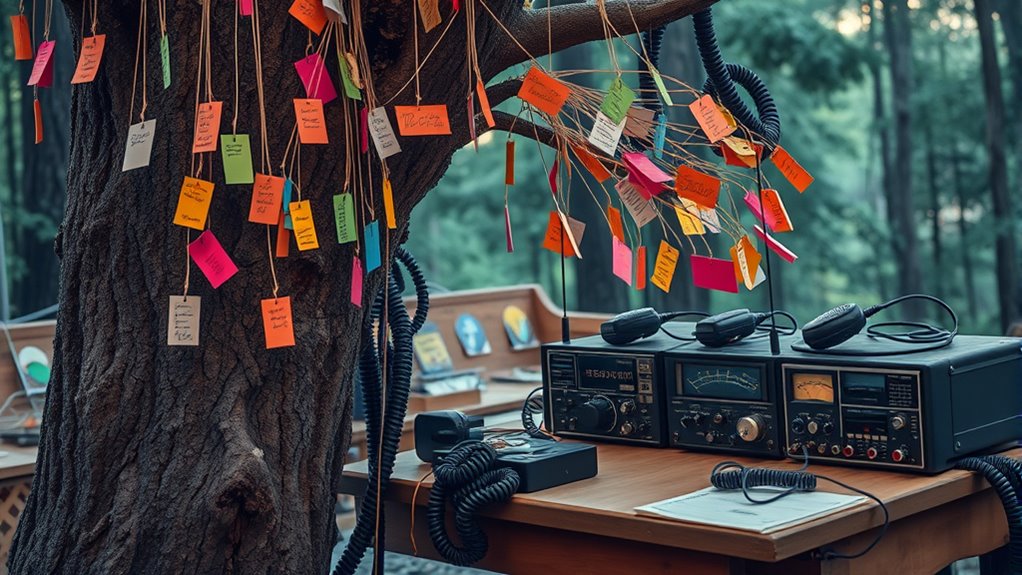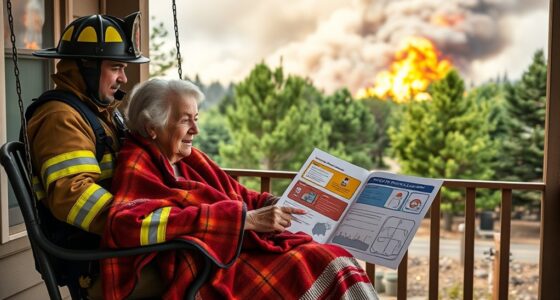During emergencies, you rely on communication tools like text trees and radios to stay connected. Text trees quickly spread alerts by passing messages through a chain of contacts, even when networks are overwhelmed. Radios provide reliable, real-time communication on dedicated frequencies, ideal for tough environments. Together, they guarantee your team stays coordinated and responders act swiftly. To discover more about how these systems work and can save lives, keep exploring these essential emergency tools.
Key Takeaways
- Text trees rapidly disseminate alerts through a chain of contacts, ensuring quick message spread during infrastructure failures.
- Radio communication provides reliable, real-time coordination on dedicated frequencies, essential when traditional networks are down.
- Combining text trees and radios enhances overall emergency response by ensuring message redundancy and immediate communication.
- Text trees require minimal technology, making them effective in low-infrastructure scenarios, while radios work independently of network systems.
- Both methods are critical in disasters, helping responders stay informed, organized, and coordinated to save lives and mitigate damage.

Have you ever wondered how emergency responders stay connected during a crisis? When disaster strikes—whether it’s a wildfire, earthquake, or severe storm—communication becomes critical. Without reliable channels, responders can quickly become disorganized, delaying life-saving efforts. That’s where emergency communication systems like text trees and radio basics come into play. They’re designed to guarantee messages get through fast, clear, and efficiently, even when traditional networks are overwhelmed or down.
Text trees are an effective way to spread information rapidly among groups. Think of a chain of people, where each person forwards a message to a few others, creating a cascade of alerts. This method is simple but powerful, especially in situations where phone lines or internet services are disrupted. You can set up a predefined structure, so when an incident occurs, a designated person sends out the initial message. The recipients then pass it along to their contacts, making sure the message reaches everyone quickly. The beauty of a text tree lies in its speed and redundancy; even if some members can’t pass on the message immediately, others might, assuring coverage. Plus, it requires minimal technology: just basic mobile phones or messaging apps, making it accessible in many scenarios.
Text trees quickly spread alerts using a chain of contacts, ensuring rapid, reliable communication during disruptions with minimal technology.
Radio communication forms the backbone of many emergency response efforts. Unlike cellular networks, radios operate on dedicated frequencies, which means they’re less likely to be affected by infrastructure failures. When you understand the basics of radio communication, you realize how crucial it is. Two-way radios allow responders to coordinate in real-time, providing immediate updates and instructions. They’re portable, durable, and capable of functioning in harsh environments. When you’re in the field, radios let you maintain a constant line of contact, even when other systems fail. Different channels and frequencies are used for specific purposes, avoiding confusion during chaotic scenarios. Emergency teams often use repeaters—devices that boost radio signals—to extend their range, making sure even remote or obstructed areas stay connected. Additionally, understanding the essential role of reliable communication highlights why these systems are vital for effective emergency response.
Both text trees and radio systems are designed with redundancy and simplicity in mind. They’re built to operate under stress and in unpredictable conditions. By understanding these basics, you can better appreciate how emergency responders manage to communicate effectively during crises. Their ability to relay critical information quickly, accurately, and reliably often makes the difference between chaos and coordinated effort. Whether through a chain of texts or a network of radios, these systems help save lives and minimize disaster impacts, proving that effective communication is the first line of defense in any emergency.
Frequently Asked Questions
How Do I Start a Local Emergency Text Tree?
To start a local emergency text tree, first identify a core group of trusted volunteers in your community. Then, create a clear communication plan outlining who contacts whom and how messages are relayed. Use a reliable messaging platform or app that allows quick updates. Train your team on procedures, and regularly test the system to guarantee everyone knows their role, so you can quickly disseminate essential information during emergencies.
What Are Common Radio Frequency Bands Used in Emergencies?
Think of radio frequency bands like different lanes on a highway, each suited for specific traffic. In emergencies, you’ll mostly use VHF (Very High Frequency) and UHF (Ultra High Frequency) bands. VHF ranges from 30 to 300 MHz, ideal for outdoor and line-of-sight communication. UHF, from 300 MHz to 3 GHz, penetrates buildings better. Both are reliable for quick, clear emergency communication, ensuring your message reaches its destination without delay.
How Can I Improve My Radio Signal During a Disaster?
To improve your radio signal during a disaster, make certain you’re using the correct frequency and equipment for your area. Keep your antenna properly positioned and elevated if possible, and avoid obstructions like buildings or dense trees. Turn off unnecessary electronics to reduce interference and maintain your device’s battery. Regularly check for updates on local frequencies and stay connected with your team or emergency services for the latest information.
Are There Legal Restrictions on Emergency Radio Communications?
Yes, there are legal restrictions on emergency radio communications. You must operate on authorized frequencies and avoid interfering with official emergency channels. Unauthorized transmissions can lead to fines or legal action, so it’s essential to know your local regulations. Always use licensed equipment and follow proper procedures. Ignoring these rules could jeopardize real emergency efforts, making it indispensable to stay compliant and responsible during critical moments.
What Equipment Is Essential for Reliable Emergency Radio Use?
You need a reliable handheld or mobile radio, a good antenna, and a backup power source like batteries or a generator. Make certain your radio covers the necessary frequencies and is tested regularly. Keep spare batteries, a charger, and a clear user manual handy. Also, consider a weather-resistant model for outdoor use. These essentials help you stay connected and respond effectively during emergencies.
Conclusion
Even if you’re worried about technical skills, remember that emergency communications like text trees and radios are straightforward and designed for everyone. You don’t need to be an expert—just follow simple steps and stay connected. Taking a little time to learn these basics means you’ll be ready to help or stay informed when it counts most. Don’t wait for an emergency; prepare now so you can confidently communicate when it matters most.








